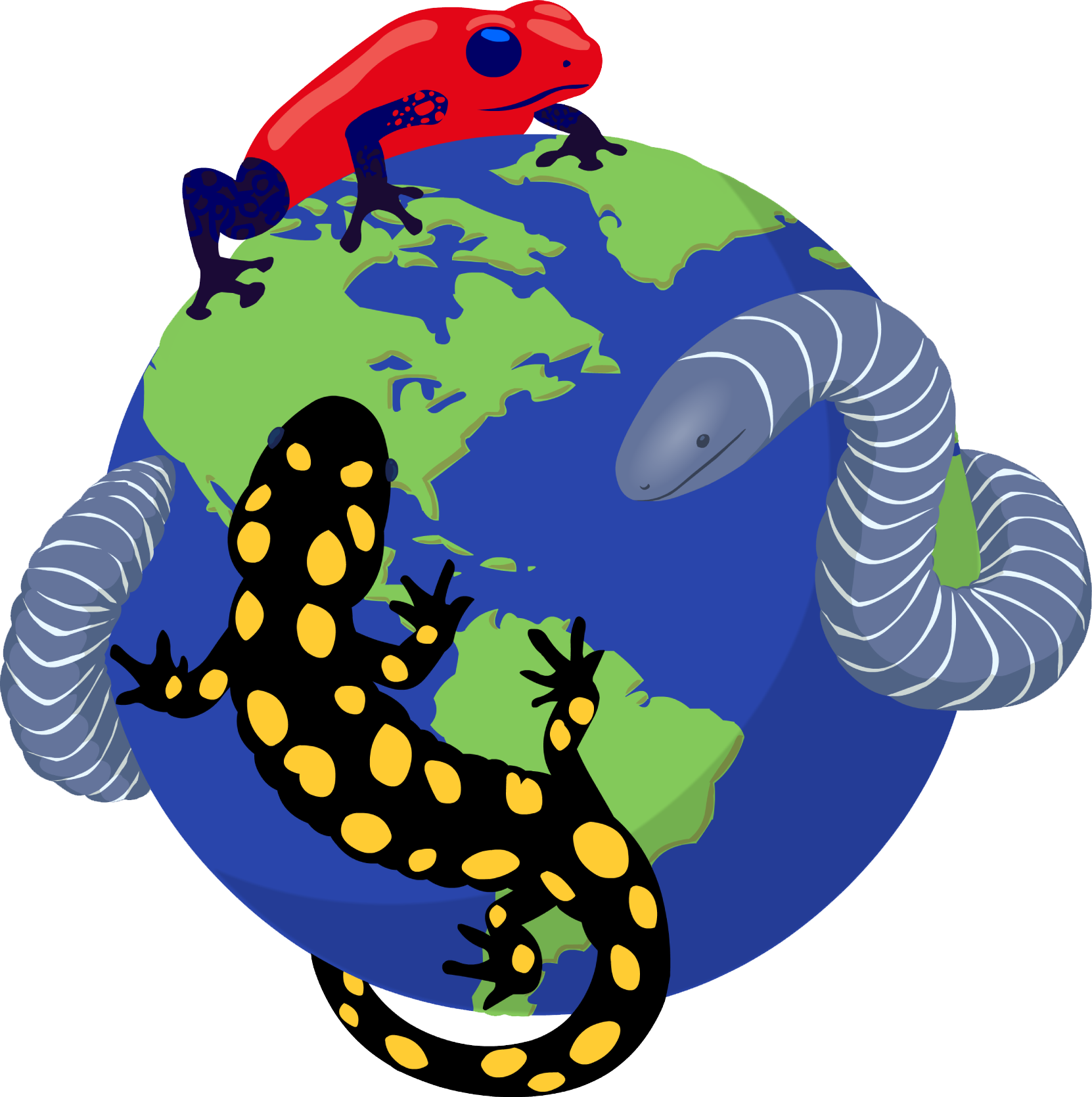|
Ceratophrys calcarata Boulenger, 1890
Venezuelan Horned Frog, Colombian Horned Frog | family: Ceratophryidae genus: Ceratophrys |
| Species Description: Boulenger, G. A. 1890. Second report on additions to the batrachian collection in the Natural-History Museum. Proceedings of the Zoological Society of London 1890: 323–328. | |
 © 2010 Andrés Acosta (1 of 5) |
|
|
|
Description DIAGNOSIS: There are lateral folds along the inner margin of C. calcarata’s tarsus like the other frogs in its clade: C. cornuta and C. stolzmanni. The Ceratophrys that dwell farther south, C. aurita, C. cranwelli, and C. ornata, have tarsal folds in a more inset position. The indentations in the back of C. calcarata’s head look deeper due to its prominent, posterior-pointing optic crests. Ceratophrys aurita, C. cranwelli, and C. ornata have lateral and media plates instead of crests. Ceratophrys calcarata has no co-ossified vertebral shield, differentiating it from its three southern counterparts that do have shields. Its feet have webbing that is of equal length between inner and outer toes. The webbing of C. cranwelli and C. ornata is reduced in toes IV and V, and the webbing of C. aurita has more extensive webbing on its inner toes than the outer toes. Ceratophrys calcarata has extensive cone-shaped horns/tubercles near its eyes, which is in contrast to C. cranwelli’s fleshier eyelid appendages. Ceratophrys ornata has miniscule eye horns, and C. stolzmanni lacks them entirely. The throat and breast of C. calcarata is are potted and dark with markings that coalesce into a more solid color, whereas C. aurita and C. cornuta have uniformly dark throats (Lynch 1982). COLORATION: In alcohol, the frog is dark olive dorsally with paler green symmetrical markings. It has an arrow-headed green band on the back that widened and split between its eyes. The lower part of the frog has brown spots. Its wrists are black (Boulenger 1890). VARIATION: Rather than having short “horns” on its upper eyelids, some C. calcarata have large cone-shaped tubercles on the same area (Lynch 1982). Distribution and Habitat Country distribution from AmphibiaWeb's database: Colombia, Venezuela
Life History, Abundance, Activity, and Special Behaviors The carnivorous diet of C. calcarata consists primarily of arthropods—namely coleopterans—vertebrates, rodents, and small reptiles (Schalk 2014). Ceratophrys calcarata engages in pedal luring to entice its smaller prey. During pedal luring, it raises its hind limbs slowly and draws its foot closely to its body. Then it vibrates and undulates its toes, revealing its inner metatarsal tubercle. This motion “beckons” prey to approach C. calcarata, allowing the frog to pounce on its food (Murphy 1976). Ceratophrys calcarata produces an antimicrobial peptide called waprin utilized for amphibian innate immunity, chemical defense against predators, and killing microorganisms and parasites that infect its body. It secretes a ceratoxin from the waprin family of toxins, which is comparable to snake venom, from its skin. The discovery of this antimicrobial peptide indicated a potential evolutionary connection between reptile and amphibian waprins (Liu et al. 2012). Larva Trends and Threats Relation to Humans Comments PHYLOGENETIC RELATIONSHIPS: Parsimony and Bayesian Inference analyses were derived from mitochondrial gene sequences that included 16S and cytochrome oxidase I as well as nuclear genes such as tyrosinase and RAG-1. They revealed that C. calcarata is most closely related to C. cornuta. Ceratophrys calcarata’s second most closely related species is C. stolzmanni (Faivovich et al. 2014). Fossil records also corroborate the relationship between C. calcarata, C. cornuta, and C. stolzmanni, given that these three frogs lack shields (Gomez and Turazzini 2021).References Faivovich, J., Nicoli, L., Blotto, B. L., Pereyra, M. O., Baldo, D., Barrionuevo, J. S., Fabrezi, M., Wild, E. R., and Haddad, C. F. B. (2014). Big, bad, and beautiful: Phylogenetic relationships of the Horned Frogs (Anura: Ceratophryidae). South American Journal of Herpetology, 9(3), 207. [link] Gómez, R. O., and Turazzini, G. F. (2021). The fossil record and phylogeny of South American Horned Frogs (Anura, Ceratophryidae). Journal of Systematic Palaeontology, 19(2), 91–130. [link] IUCN SSC Amphibian Specialist Group. 2020. Ceratophrys calcarata. The IUCN Red List of Threatened Species 2020: e.T56336A85857371. https://dx.doi.org/10.2305/IUCN.UK.2020-3.RLTS.T56336A85857371.en. Accessed in September 2024 Hou, P.-C. L., Shiau, T.-W., Tu, M.-C., Chen, Chen, T.-Y., Tsai, Y.-F., Lin, C.-F., and Wu, S.-H. (2006). Exotic Amphibians in the Pet Shops of Taiwan. Taiwania, 51(2), 87–92. [link] Liu, D., Wang, Y., Wei, L., Ye, H., Liu, H., Wang, L., Liu, R., Li, D., and Lai, R. (2013). Snake venom-like waprin from the frog of Ceratophrys calcarata contains antimicrobial function. Gene, 514(2), 99–104. [link] La Marca, E. (1986). Description of the tadpole of Ceratophrys calcarata. Journal of Herpetology, 20(3), 459. [link] Lynch, J. D. (1982). Relationships of the frogs of the genus Ceratophrys (Leptodactylidae) and their bearing on hypotheses of Pleistocene forest refugia in South America and punctuated equilibria. Systematic Zoology, 31(2), 166. [link] Murphy, J. (1976). Pedal luring in the Leptodactylid Frog, Ceratophrys calcarata Boulenger. Herpetologica, 32(3), 339–341. [link] Schalk, C. M., Montaña, C. G., Klemish, J. L., and Wild, E. R. (2014). On the diet of the frogs of the ceratophryidae: synopsis and new contributions. South American Journal of Herpetology, 9(2), 90–105. [link] Vieira, K. S., Montenegro, P. F., Santana, G. G., and Vieira, W. L. (2018). Effect of climate change on distribution of species of common horned frogs in South America. PLOS ONE, 13(9). [link] Originally submitted by: Sophie dela Cruz (2024-09-23) Description by: Sophie dela Cruz (updated 2024-09-23)
Distribution by: Sophie dela Cruz (updated 2024-09-23)
Life history by: Sophie dela Cruz (updated 2024-09-23)
Larva by: Sophie dela Cruz (updated 2024-09-23)
Trends and threats by: Sophie dela Cruz (updated 2024-09-23)
Relation to humans by: Sophie dela Cruz (updated 2024-09-23)
Comments by: Sophie dela Cruz (updated 2024-09-23)
Edited by: Ann T. Chang (2024-09-23) Species Account Citation: AmphibiaWeb 2024 Ceratophrys calcarata: Venezuelan Horned Frog <https://amphibiaweb.org/species/5719> University of California, Berkeley, CA, USA. Accessed May 30, 2025.
Feedback or comments about this page.
Citation: AmphibiaWeb. 2025. <https://amphibiaweb.org> University of California, Berkeley, CA, USA. Accessed 30 May 2025. AmphibiaWeb's policy on data use. |




 Map of Life
Map of Life